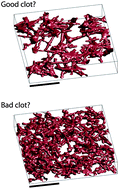A study of microstructural templating in fibrin–thrombin gel networks by spectral and viscoelastic analysis
Abstract
We report a study of the microstructural templating role of incipient fibrin–thrombin gels by analysis of rheological and

* Corresponding authors
a College of Engineering, Swansea University, Swansea, UK
b
College of Medicine, Swansea University, Swansea, UK
E-mail:
k.m.hawkins@swansea.ac.uk
Tel: +44 (0)1792 295058
c NISCHR Haemostasis Biomedical Research Unit, ABMU NHS Trust Hospital, Morriston, Swansea, UK
d Centre for NanoHealth, Swansea University, Swansea, UK
We report a study of the microstructural templating role of incipient fibrin–thrombin gels by analysis of rheological and

 Please wait while we load your content...
Something went wrong. Try again?
Please wait while we load your content...
Something went wrong. Try again?
D. J. Curtis, P. R. Williams, N. Badiei, A. I. Campbell, K. Hawkins, P. A. Evans and M. R. Brown, Soft Matter, 2013, 9, 4883 DOI: 10.1039/C3SM50263E
To request permission to reproduce material from this article, please go to the Copyright Clearance Center request page.
If you are an author contributing to an RSC publication, you do not need to request permission provided correct acknowledgement is given.
If you are the author of this article, you do not need to request permission to reproduce figures and diagrams provided correct acknowledgement is given. If you want to reproduce the whole article in a third-party publication (excluding your thesis/dissertation for which permission is not required) please go to the Copyright Clearance Center request page.
Read more about how to correctly acknowledge RSC content.
 Fetching data from CrossRef.
Fetching data from CrossRef.
This may take some time to load.
Loading related content
